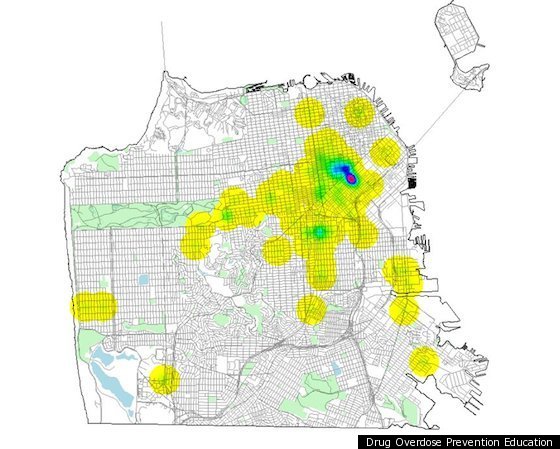This article comes to us courtesy of SF Weekly's The Snitch.
For the last eight years, the city's Department of Public Health has been dealing a drug that can stop a heroin overdose in its tracks -- and it appears to be working. The city has just ticked off its 600th life saved since it started doling out the drug in 2003.
The city prescribes the drug -- known by the trademark Narcan, more formally as naloxone -- to users through the city's needle-exchange sites, nonprofits, and community services like Glide Memorial Church. They also conduct training in county jails, and prescribe the drug to people who live in residential hotels, plus to the friends and family of heroin users. The drug works for opiates such as heroin and morphine, and puts a comatose body into withdrawal within one to three minutes, creating an undesirable sensation within moments.
A map below that shows where Narcan has been used illustrates -- perhaps not surprisingly -- that the hotbed of life-saving is happening near Sixth and Market streets, extending into the Tenderloin -- a San Francisco hub of drug activity.
The 600 lives potentially saved by the drug are no small thing, especially when you find out that the city's emergency department visits due to heroin were cut in half from 2004 to 2009. "San Francisco has always been a heroin town, says Alice Gleghorn, DPH's head of Community Behavioral Health Services. "At one time, San Francisco had an overdose death every day, and that rate has really gone down. I hope our naloxone programs have contributed to that drop. But we don't have the money to do the research."

The Department of Public Health spends $73,000 a year for the Oakland-based Drug Overdose and Prevention Education Project (DOPE Project) to buy, distribute, and train people in the use of Narcan. Eliza Wheeler, the director of the program, says they've trained 3,000 people to date. (The Chron wrote about the program last year, when the program reported 500 lives saved.)
The DOPE Project used to distribute injection-administered Narcan, but since May 2010, have switched over to a more expensive nasal spray, costing $20 a dose instead of $6.50. The program counts the total lives saved by the number of people reporting back about using the drug or coming back for a refill - at which time the health workers ask them a series of questions including the closest intersection of where they used it.
While EMTS have carried Narcan in ambulances for 40 years, cities across the country started deciding to train lay people, including drug users, to inject it in the mid-'90s, Wheeler says. She likens it to how lay people can also inject insulin, and says drug users obviously aren't squeamish about needles.
"The folks we see are pretty adept with administering drugs, so they'll be okay. People are very capable and willing to save their friends' lives ... my experience is that people are really proud of themselves," Wheeler says.
Last year, then-Gov. Arnold Schwarzenegger signed a bill sponsored by Assemblyman Tom Ammiano (D-San Francisco) which kept those people who had completed the Narcan training from being held liable after administering the drug.
As to critics who say Narcan encourages heroin use, Wheeler counters, "It makes zero sense. Being given naloxone is a very unpleasant experience; it puts people into instant withdrawal. If someone has a Narcan kit, it's not a reason not to go to treatment if they're ready for treatment. They don't say now I have this, I can use drugs for the rest of my life.'"
For more San Francisco politics and beyond, follow The Snitch on Twitter.